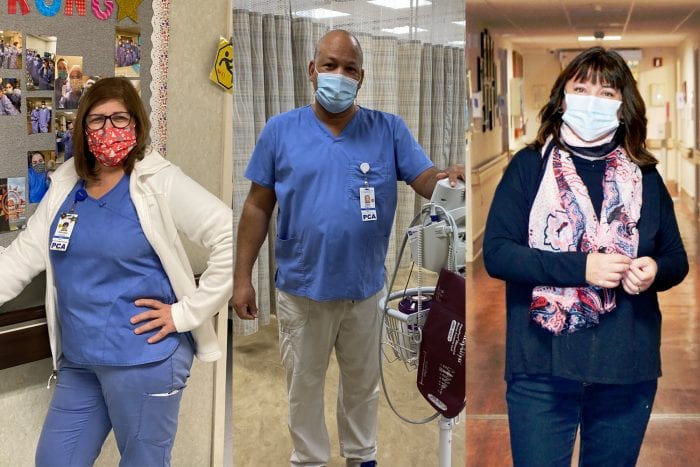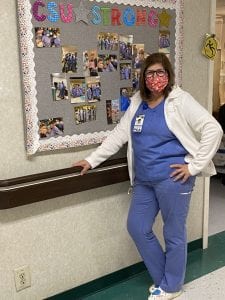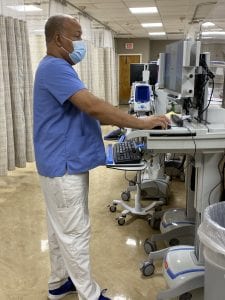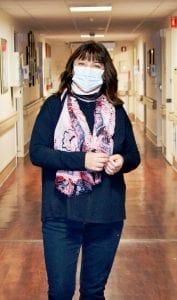Health Care Workers Chronicle Their COVID Ordeals
From Helper to Patient, Then Back to Helper

Health care professionals often sympathize with their patients, offering support as they deal with painful and difficult symptoms. With COVID-19, some health care professionals in the local area also became patients themselves. Feliciano Lucuix, Gene Rogers, two patient care assistants at St. Catherine of Siena Medical Center, and Carolyn Germaine, Director of Nursing for the Transitional Care Unit at Mather Hospital, shared their experiences with TBR News Media.
Feliciano Lucuix
Feliciano Lucuix, whose last name is pronounced like “lou quicks,” battled through COVID-19 in the first few weeks after the pandemic hit Long Island. A patient care assistant at St. Catherine of Siena Medical Center, she was in a restroom in March with a COVID-19 patient who vomited on her. Days later, she said she had a high fever and struggled to breathe.

When her symptoms started, she had a 99.7-degree fever and pain throughout her body. She lost her sense of smell and her fever climbed to 102.8. She took a COVID test, which would take three days to provide results.
Before her diagnosis, she reached a point where she couldn’t tolerate losing her appetite and having her throat “feel like sandpaper,” she said.
Lucuix, who never smoked and practices yoga twice a week and swims, drove herself to the hospital, where she remained for six days, from March 24 through March 30. During that time, her daughter and son couldn’t visit.
Her son called every day and spoke to the nurses. Lucuix said he didn’t believe her when she said she was okay. The son also spoke with the doctor, who said his mother’s condition was improving.
While she endured challenging symptoms and discomfort, she appreciated the help and attention she received.
“Everybody take care of me wonderful,” said Lucuix, who was born in Argentina to an Italian mother and a French father and speaks Spanish, Italian, English and some French.
Even after she left St. Catherine, she couldn’t return to work for 37 days, as she traversed the slow road to recovery.
During Lucuix’s rehabilitation, her son, whose wife had his first child and Lucuix’s fourth grandchild, urged her to consider retiring.
Lucuix couldn’t wait to return to the COVID floor at St. Catherine. She has used her experience to offer patients on her floor empathy and support.
“I tell my patients, I take their hands, I say, ‘Listen, I was in there, too. I know what you’re feeling,’” she said. “I know you’re scared. I know you’re feeling you can die. If I can do it” then the patient can, too.
COVID-19 continued to affect her in other ways, even after her fever broke and she started to recover. Lucuix had headaches and started to lose her hair. She also had trouble sleeping, as viral nightmares interrupted her rest. Her doctor recommended that she speak with a therapist.
“I feel more comfortable every day,” she said.
Lucuix does what she can to protect herself, including taking vitamins, using personal protective equipment and washing her hands regularly.
Lucuix shares her experiences with her coworkers and her patients. She has also donated her antibody-filled plasma twice.
“I donated blood so other people can survive,” Lucuix said. “I’m proud to do that.”
Lucuix’s daughter, who works as a Patient Care Assistant, is following in her footsteps. Her daughter has applied to nursing programs to study to become a registered nurse. Lucuix with her granddaughter about considering the same field.
They would “like her to follow” in their footsteps, Lucuix said.
Lucuix said she is prepared to help patients during the second wave, which started to hit the Long Island community amid the colder weather and as families and friends gather in smaller groups.
“I’m ready to fight again,” Lucuix said. “I want to be strong for my patients, strong for my family.”
Gene Rogers
A patient care assistant at St. Catherine of Siena Medical Center, Gene Rogers started to feel ill March 23. He had a 101-degree temperature and was told to take a few days off, drink plenty of fluids, and take Motrin. He locked himself in his room, in case he had COVID, preventing his wife Bethan Walker-Rogers, their 16-year old son Phoenix and 10-year old son Charlie and even his dogs from having any contact with him.

Two days later, he was so uncomfortable that he decided he needed to go to the hospital. Walker-Rogers asked if she wanted her to drive him, but he said she should stay home and take care of their younger children. The Rogers also have an older child, Maya, who is 21.
As he drove, Rogers said he felt the car swerving when he passed a police officer.
“I was shocked he didn’t pull me over,” Rogers said.
When he arrived at St. Catherine, his temperature had spiked to 103.8.
Mary Jane Finnegan, Chief Nursing Officer at St. Catherine, offered Rogers reassurance.
“I don’t remember the whole thing about the ER that night,” Rogers said. “I remember [Finnegan] coming over to me and saying, ‘We’re going to take good care of you.’”
Like Lucuix, Rogers had no appetite. He was also having trouble breathing. The nurses kept telling him to lay on his stomach.
He had an odd sensation in his feet and was achy. He was in the hospital for eight days.
Rogers felt that the entire staff lived up to Finnegan’s promise. When he had a fever of 104.1, the nurses put ice packs under his arms.
“I’m putting them at risk while they are taking care of me,” he thought to himself on the bed. “Everyone I see, I try to say, ‘Thank you.’”
Walker-Rogers works in the dietary department at St. Catherine. Even while he was in the hospital, she couldn’t visit. She did walk by and look in the window, but she wasn’t allowed in.
Rogers entered the hospital on March 26 and was discharged April 3.
Although he was eager to return to work, a low-grade fever and, eventually, double pneumonia, kept him out for seven weeks.
Yet again, he isolated from the family and his dogs, who were scratching at the door regularly to see him.
During the worst of his condition, Rogers lost 35 pounds, which, he said, he has since regained.
Rogers added he never considered leaving his profession or St. Catherine.
“The people here are like my second family,” said Rogers, who has been at St. Catherine for 35 years. “I see them more than I see my own family.”
Rogers’s mother, Janice Foote, who lives in Raleigh, North Carolina, suggested that it might be time to retire or to do something else.
He said he had to return.
“I love my job,” Rogers said. “I enjoy what I do. I couldn’t wait to come back.”
When he started to work, Rogers said he was short of breath from running around.
Recalling the uncertainty and difficulty he and his family faced when he was sick, Rogers said his wife asked him what she’d do if anything happened to him. During the worst of his experience, Rogers said his oldest daughter Maya got so upset that she had to leave and take a walk.
As for how the experience affected him professionally, Rogers said, “you definitely look at it from a different perspective, being in someone else’s shoes.”
Rogers described himself as the type of person who is always asking if a patient needs something else.
“It look at it even more now, after being to that point” with his own illness, Rogers said.
Rogers’s daughter Maya, a junior at St. John’s University in Queens, is following in her parents’ footsteps. A biology major, she aspires to be a physician and is leaning towards emergency medicine.
Carolyn Germaine
Of all the tangible and intangible gifts Carolyn and her husband Malcolm Germaine have exchanged during the over four decades they’ve known each other, this had to be the worst.

Director of Nursing for the Transitional Care Unit, Carolyn Germaine contracted COVID-19 in March and, soon thereafter, passed it along to Malcolm.
Her husband was choking at night and, despite being a nurse, Carolyn Germaine felt helpless, particularly in the earlier phases of the disease when health care workers weren’t using steroids that have become a part of more effective treatment.
“I feel terrible he got sick,” Germaine said. “It’s not something you ever want to bring home with you.”
Germaine’s battle with COVID-19 started March 23, when she developed a fever and aches all over her body that felt like every one of her joints had arthritis. By the 26th, she had a positive diagnosis. When she started to feel better, she thought she might return to work.
The next morning, she woke up with a 103-degree fever and, like so many other COVID patients, struggled to catch her breath.
“Nurses are bad patients,” Germaine said. “We think we can manage everything ourselves.”
Nonetheless, by Tuesday, the 31st, she recognized that the oxygen in her blood, which she tested on her own at home, was dropping to the low 90s. She went to the ER, where she convinced her colleagues to let her return home.
Another hospital official called and said, as Germaine recalled, “What are you doing? You need to come back.”
She was admitted on Tuesday evening, where she struggled through the most extreme discomfort she’s ever had. Her nausea, fatigue, and brain fogginess made her so uncomfortable that she asked her doctor to knock her out.
“It’s terrifying because you are isolated, and you want to stay isolated,” Germaine said. She didn’t want any of her friends or staff members to come into the room, where she could expose them to the virus that was challenging her system.
Germaine described the care she received as “exceptional.” The staff at Mather regularly checked in on her, even if it was just from the door. Struggling with thirst, she received numerous drinks at the door.
She knew the staff managed through extreme stress. Even in her brain fog, she could hear all the code blues and rapid response alerts all day.
“I’ve been in the hospital for 33 years and that doesn’t happen,” she said. “If there’s a code blue or rapid response, those are rare occurrences.”
While she was trying to recover in the hospital, Germaine said she was incredibly short of breath, even when she made the short walk from the bed to the chair. She forced herself to go back and forth, which she knew was better than remaining in bed all day.
Germaine vomited so frequently that she lost 15 pounds in the five days she was hospitalized.
“I didn’t think I was ever going to feel better,” said Germaine, who also lost a sense of smell that has only partially returned nine months later.
When she finally left the hospital, it took her five weeks to return to work. Germaine credits her daughter Laura, who lives with Carolyn and Malcom and is a social worker at Northwell, with taking care of her parents. Somehow, despite being around them through the worst of it, Laura, who is hoping for a “normal” wedding next summer, didn’t get sick.
During that period, the Germaine’s first grandchild, Greyson, was born April 12. She and her husband couldn’t visit him in person right away.
An avid walker who runs up and down the stairs at the hospital, Germaine needed a few more months to feel more normal.
She said she has also felt some sense of survivor’s guilt, because she wasn’t able to help out at the hospital when the need was the greatest.
Germaine said the staff has already been dealing with the effects of the second wave.
Within a 90-minute period recently, the hospital had four rapid responses, which means a dramatic change for patients, either because of oxygen levels dropping, a change in mental status, a drop in blood pressure or anything that might require immediate attention.
The rapid response call brings a whole medical team to the bedside.
The hospital would normally have a few of these in a week but having four in 90 minutes is extraordinarily stressful.
“People who don’t work in the field do not understand the amount of stress that the staff is feeling,” Germaine said. “It’s the entire staff. It’s every department that works here. It’s a very unpredictable time.”
Unlike the first wave, when other states sent medical teams to help in Suffolk County, those states are in the midst of their own crises, which means that no help will be coming, she said.
Germaine urged people to wear masks, remain socially distanced and limit any gatherings, even during the holidays.
Despite the anxiety, tension and memory of her own hospitalization, Germaine said she never considered leaving the hospital or her profession.
“Nothing is more satisfying than taking care of patients and helping families,” Germaine said. “You’re made to do it. I can’t imagine not doing it.”
Having the virus affects Germaine’s approach to her job.
“Every personal experience makes you a better nurse,” Germaine said. “You can go to patients and their families from a place of knowledge.”






